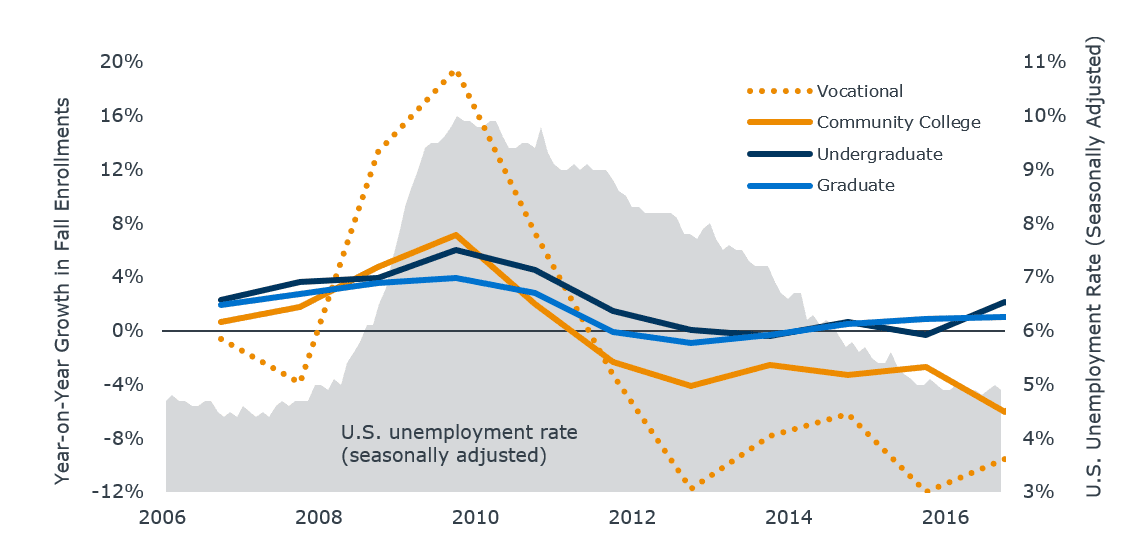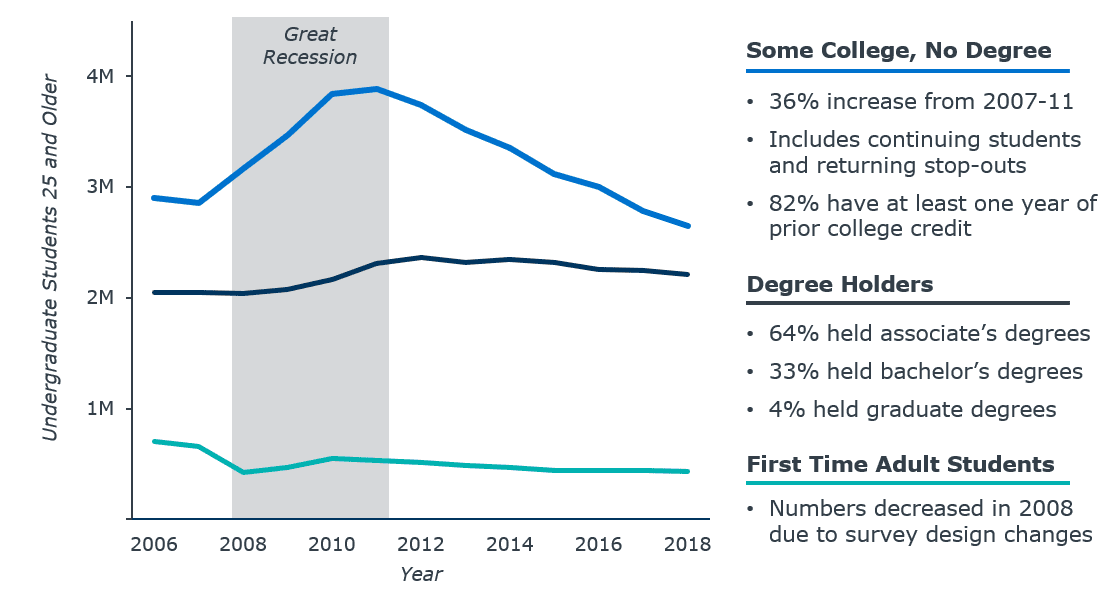What the 2008 Recession tells us about the future of the adult degree completer market
What motivates potential adult degree completers to go back to school? This past year, EAB surveyed more than a thousand prospective degree completers and found that nearly all feel that a four-year degree is something to be proud of, a useful career investment, and something that they can achieve. But despite this strong interest and motivation to go back to school, only 9% of survey respondents had applied to a program.
For many degree completers, the thing that made them re-enroll was a major shift in life circumstances: a catalytic life event.
The 6 stages of the adult degree completer journey to enrollment
In normal times, marketing leaders can’t predict when these moments might strike for an individual prospect. But we aren’t living in normal times. COVID-19 has disrupted nearly everyone’s lives and livelihoods. Can a nationwide crisis become a shared catalyst for millions of potential degree completers?
Who are adult degree completers?
Adult degree completers include students 25 or older who are completing an associate or bachelor’s degree without a prior degree or certificate.
Lessons (and limitations) from the Great Recession
During periods of high unemployment, more people turn to higher ed as a path to a better, more secure career. This is a trend we saw clearly during the Great Recession when unemployment approached 10% and enrollment in higher education grew at its fastest rate in over 30 years.
However, preliminary figures for Fall 2020 suggest that enrollments at many institutions are down compared with last year, especially at community colleges. This is because COVID-19 is far more than just an economic crisis. Many potential degree completers now must contend with children attending school online from home and restrictions on their own in-person learning and guidance options. These factors seem likely to complicate re-enrollment plans, at least in the short-term.
The emergence of a vaccine should make social distancing a thing of the past. However, a vaccine won’t immunize us from the economic damage that COVID-19 has caused. Assuming a vaccine emerges soon, the Great Recession offers us our guide for what a post-pandemic enrollment landscape might look like.
The Great Recession turbo-charged sub-baccalaureate enrollment
During the Great Recession, not all institutions experienced enrollment increases equally. The chart below shows how enrollment changed for each higher education sector. As national unemployment, the grey area on the chart, rose between 2008 and 2010, all sectors of higher education saw their year-on-year enrollment growth rise. But community colleges and vocational institutions saw the largest gains.
Sub-baccalaureate market grew the most during the last recession

Community colleges account for around 90% of students not enrolled in four-year institutions. After barely growing from 2003 to 2006, the recession boosted community colleges’ growth by nearly 5% in the fall of 2008 and over 7% in the fall of 2009. But vocational institutions saw the most dramatic growth. These institutions, which train cosmetologists, auto mechanics, medical assistants, and others, grew enrollments by nearly 20% in the fall of 2009.
Adult students drove the countercyclical boom at 4-year institutions
The recession’s impact on four-year institutions was modest. For “traditional-aged” students, or those younger than 25 years old, the Great Recession had virtually no impact.
Nearly all the enrollment growth caused by the Great Recession came from adult students, and when we only look at the growth rate for these students, the recession’s impact was very large. Between 2007 and 2009, adult enrollments at four-year institutions increased at an annual rate of nearly 10%, faster growth than even the community colleges saw.
-
10%
increase in adult enrollments at 4-year institutions during the Great Recession
Recession-era adult students are often degree completers
I anticipated that degree completers would account for some of the increase in adult enrollments. But after analyzing data from the American Community Survey on adult students and their prior education attainment, I was surprised to find that almost all of the recession-era increase came from adult degree completers, or students 25 or older completing an associate or bachelor’s degree. It’s not simply that the recession boosted adult enrollments, but specifically that the Great Recession pushed adult degree completers to go back to school.
Adults with some college, but no degree accounted for nearly all of the Great Recession’s undergraduate countercyclical bump

2020’s word of the year: Uncertainty
The big takeaway is that a nationwide economic crisis can act as a catalyst for degree completion prospects. But while the pandemic rages, many will have to delay their plans. Once the pandemic comes under control, institutional leaders should prepare for a potential surge in adult degree completers, with the knowledge that it is far from a sure thing in our current environment.
Increasing degree completer enrollment requires sophisticated enrollment strategy
Recruiting adult degree completers is further complicated by a lack of test-taker lists to identify prospective students. And degree completers often face significant obstacles to reenrollment, such as competing professional and personal obligations and the reasons that led them to stop out in the first place. To recruit adult degree completers, enrollment leaders need to understand the factors that drive and delay this audience’s journey to reenrollment—and ensure their marketing strategy is highly responsive to student behavior.
How one university used data-driven marketing to grow degree completer enrollments
But the possible increase in adult degree completers isn’t simply an opportunity for institutions to grow enrollments while budgets are tight. It also offers a prime opportunity for colleges and universities to step forward and lead in the nation’s recovery from this crisis.

More Blogs

4 questions domestic students will ask before applying to your graduate program

When Grad PLUS disappears: What 8,000+ grad students said about paying for school
